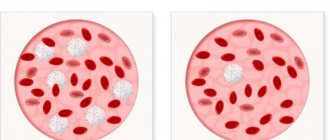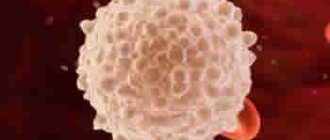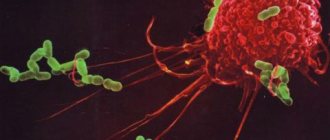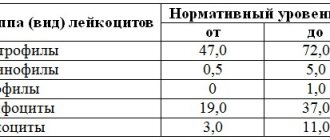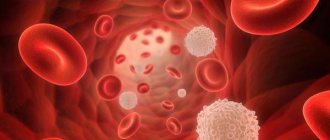Lymphocyte and white blood cell levels are indicators that help assess the proper functioning of the immune system. No less important is the leukocyte index - the ratio of different types of white blood cells. If leukocytes are low and lymphocytes are high, we are talking about the presence of pathological conditions that require treatment.
How does immunity work?
In the immune response system, there are two methods of combating a foreign agent:
- Using phagocytosis. In this case, the pathogen is destroyed by special cells. They are absorbed completely or partially, followed by digestion by lysosome enzymes (subject to phagocytosis).
- With the help of humoral substances. In this case, the foreign agent is identified and immunoglobulins (antibodies) are released against it. These special substances destroy the pathogen by interacting with it.
To carry out an immune response, 3 types of leukocytes can be found in the blood: granulocytes, monocytes and lymphocytes.
Cell functions
Blood contains many types of cells that perform different functions, from transporting oxygen to producing antibodies. Blood cells can be divided into red and white - lymphocytes and erythrocytes. Red blood cells make up the bulk of cells circulating in the blood and carry oxygen. White blood cells fight infection and digest the remains of destroyed cells.
Leukocytes are divided into 3 main groups: granulocytes, monocytes and lymphocytes. Immunity can be compared to an army. Monocytes in it will play the role of “heavy artillery”, neutrophils - “private soldiers”, lymphocytes can be called “officers”.
What are lymphocytes
Lymphocytes are an important category of blood cells for the immune system because they can repeatedly fight harmful microorganisms, providing reliable protection to the body.
Lymphocytes and monocytes live longer than other blood cells—sometimes even several years. Their destruction occurs in the spleen. The function of lymphocytes depends on their specialization.
Lymphocytes are divided into several categories:
- T cells. They make up 75%. T cell receptors recognize protein antigens.
- B cells - 15%.
- NK cells. Their share is 10%.
Each category has its own purpose.
What are monocytes
Monocytes are white blood cells that are involved in fighting infections. They absorb and destroy various microorganisms. When they leave the blood, they turn into macrophages, which fight infections and dispose of dead cells. Monocytes are able to move quickly and freely penetrate the walls of capillaries, entering the intercellular space. There they catch harmful microorganisms and neutralize them.
Important information: What does low red blood cells mean in the blood of an adult (causes in women)
These are active cells. They are formed in the bone marrow. These cells do what is impossible for other white blood cells - they eliminate microorganisms even in a highly acidic environment.
What functions do monocytes perform?
Monocytes circulating in the blood are young cells and travel to tissues to become mature histiocytes and macrophages. They migrate to the mucous membranes and skin, which are the first to encounter foreign agents. There, macrophages and histiocytes phagocytose the pathogen.
An increase in the number of monocytes (monocytosis) is a sign of a foreign agent entering the tissue. There the need for macrophages increases. Since the precursors of macrophages are monocytes, their production increases. During their delivery to tissues, monocytosis in the blood can be seen during a blood test. An increase in monocytes can be observed with:
- inflammatory diseases of an infectious nature of an acute or chronic course (viral, fungal, bacterial, parasitic);
- condition after suffering infectious diseases;
- autoimmune diseases;
- the presence of malignant diseases;
- oncohematological processes;
- poisoning with phosphorus, tetrachloroethane.
Absolute monocytosis can be caused by diseases such as mononucleosis, influenza, ARVI, tuberculosis, candidiasis, syphilis, appendicitis, adnexitis, rheumatoid arthritis, etc.
Lymphocytes and leukocytes are reduced
Reduced lymphocytes in an adult indicate the presence of the following pathological conditions:
- Congenital or acquired forms of immunodeficiency. The syndrome can occur against the background of genetic pathologies, mutations, HIV infection, or taking immunosuppressive drugs.
- Bone marrow hypoplasia. The functions of the hematopoietic system are disrupted during severe infections, massive blood loss or autoimmune damage.
Other reasons for a decrease in the number of protective cells include the following factors:
- influence of radiation;
- age-related changes in the bone marrow, accompanied by early extinction of its functions (a reduced level of blood cells is detected when hematopoietic tissue is replaced by connective tissue);
- genetic forms of leukopenia;
- autoimmune pathologies accompanied by the destruction of healthy blood cells;
- exhaustion of the body caused by fasting, dysfunction of the gastrointestinal tract or cancer;
- bone marrow destruction associated with the penetration of metastases;
- underdevelopment of the hematopoietic system;
- chronic bacterial infections.
A reduced number of protective cells is also found in people suffering from kidney, liver or heart failure. Taking medications aimed at reducing the severity of the manifestations of the underlying disease helps to increase the indicator.
What functions do lymphocytes perform?
Lymphocytes perform several functions. They regulate the process of starting and stopping the immune response, recognize foreign proteins, produce immunoglobulins, destroy pathogen cells, store information about the encounter, and remember the genetic characteristics of the introduced agent. Thus, they participate in two directions of the immune response: cellular (phagocytosis) and humoral (antibody production). Lymphocytes are elevated in the presence of:
- viral diseases;
- some types of medicinal substances: levodopa, narcotic analgesics, valproic acid, phenytoin and others;
- disorders of the blood system - chronic lymphocytosis, heavy chain disease and the period of leukemia lead to lymphocytosis;
- exposure to toxic chemicals - the growth of lymphocytes is promoted by carbon disulfide, lead, tetrachloroethane, arsenic, etc.
An increase in the total number of lymphocytes is observed in the occurrence of most diseases from toxoplasmosis and leptospirosis to ARVI. The presence of absolute lymphocytosis is accompanied by enlargement of the lymph nodes of the liver and spleen.
Normal values
The norm of protective cells is determined by the age and gender of the person.
Lymphocytes
Normal lymphocyte levels are as follows:
- children 1-24 months - 2-11 units;
- children 2-10 years old - 2.6-8 units;
- teenagers 11-16 years old - 1.2-5.2 units;
- adult men and women - 1-4.5 units.
As the body ages, the number of lymphocytes begins to gradually decrease.
Leukocytes
Normal indicators of the number of leukocytes are the following values:
- children under 12 months - 6-18 billion/l;
- children 2-6 years old - 5-16 billion/l;
- children 6-16 years old - 4.5-11 billion/l;
- adult men - 4.2 billion/l;
- adult women - 4-10.5 billion/l.
After 50 years, rates decrease, which is considered a variant of the norm.
Important information: What is accelerated ESR subsidence syndrome (causes)
In what cases is a combination of monocytosis and lymphocytosis observed?
Due to the difference in the life span of monocytes and lymphocytes, their preferential localization and functions, a combined increase in their level in the blood will be observed during acute infectious processes caused by a viral pathogen. This change in blood test is observed with ARVI, influenza, rubella, herpes, chicken pox, etc. What is important is the relative decrease in the number of neutrophils in the blood test. If such a laboratory picture is available and additional research methods are carried out, the doctor will prescribe treatment with antiviral drugs.
Deviations
A deviation is considered to be both a decrease and an increase in the number of lymphocytes and leukocytes. Changes can affect one or both types of cells.
Lymphocytes are low and leukocytes are high
A temporary increase in leukocytes and a decrease in lymphocytes occurs under the influence of the following factors:
- penetration of pathogenic microorganisms causing purulent inflammatory reactions of a local nature;
- generalized bacterial, viral or fungal infections;
- severe allergic reactions caused by the use of certain foods or medications, contact with household chemicals or pollen.
If lymphocytes are steadily decreasing and leukocytes are increased in a child or adult, we may be talking about the presence of the following pathologies:
- HIV infection of various stages, including AIDS;
- malignant tumors of the hematopoietic system;
- complications of long-term administration of glucocorticosteroids;
- chronic bacterial and viral infections complicated by dysfunction of internal organs;
- consequences of chemotherapy and radiotherapy.
More rare pathological conditions in which leukocytes are increased and lymphocytes are decreased include:
- mixed infections characterized by severe course (septicemia, pneumonia);
- dysfunction of the bone marrow, for example, damage to hematopoietic germs;
- metastatic malignant tumors;
- autoimmune inflammatory processes;
- severe diseases of the endocrine system;
- congenital immunodeficiency of non-infectious origin.
Lymphocytes are increased and leukocytes are decreased
If leukocytes are reduced and lymphocytes are increased in an adult, it is necessary to examine the body for the presence of pathologies. Such diseases include:
- genetic pathologies accompanied by dysfunction of the hematopoietic system;
- severe lack of iron, folic acid and B vitamins necessary for normal maturation of leukocytes and delivery of cells to inflammatory foci;
- malignant tumors that metastasize to the bone marrow;
- aplastic anemia;
- accelerated destruction of white blood cells caused by autoimmune pathologies;
- consequences of treatment with highly effective chemotherapeutic agents;
- complications of long-term administration of anticonvulsants;
- hypoplasia and aplasia of the bone marrow that occurs when exposed to ionizing radiation;
- acute viral infections;
- systemic blood diseases;
- bronchial asthma;
- dysfunction of the thyroid gland or adrenal glands;
- serum syndrome;
- neurotic disorders;
- hemorrhagic vasculitis;
- allergic reactions to certain medications;
- heavy metal poisoning.
Important information: What do elevated eosinophils in the blood of an adult indicate?
Women have low white blood cells due to the following reasons:
- taking painkillers during menstruation;
- use of hormonal contraceptives.
There are many lymphocytes and few leukocytes in a child’s blood with the following diseases:
- purulent lesions of soft tissues;
- acute respiratory viral infections;
- generalized bacterial and fungal infections;
- oncological diseases of the hematopoietic system;
- complications of burns and other injuries.
Common combinations of cellular reactions
It was already noted above that doctors rarely consider absolute indicators as a sign of a disease. In most cases, we are talking about a comprehensive decoding of the analysis. In this case, different combinations are identified. The most common are the following.
A combined increase in monocytes and lymphocytes may be a sign of an acute infection of viral origin. These are not only simple respiratory diseases, but also measles, rubella or chickenpox, which are dangerous for some categories of people. In this case, neutrophils become low, and doctors usually start working with antiviral therapy.
The combination of elevated monocytes and eosinophils necessarily manifests itself if a person encounters an allergen or parasites. We are talking about chlamydia and mycoplasma. The distinctive symptom of patients in this case is a dry cough, which takes a long, painful form. However, such important clinical signs as wheezing in the lungs are absent.
The combination of monocytes and basophils also cannot be ignored. Basophils refer to cells that are among the first to respond. They rush towards the infectious focus even before everyone else starts working. Increased monocytes and basophils combined with each other can cause long-term treatment with hormonal spectrum drugs.
Moreover, against the background of increased basophils, a large number of macrophages and lymphocytes are always present. They act due to the production of serotonin, histamine and a number of other substances that enhance the inflammatory process.
Eosinophils and monocytes are elevated in the child
The normal limits for reading leukocytes in a child are somewhat different from adult norms:
- monocytes - from 3 to 12% after birth, the upper norm increases to 15% in the first weeks, before a year it decreases to 10%, and after that it is equal to adult (3 - 9%);
- eosinophils - the percentage rate is the same as in adults (up to 5%), but the absolute amount in an adult is not more than 0.4 x 10⁹ per 1 liter, and in a child - 0.7 x 10⁹/l.
Important! When interpreting the results, not only age-related, but also daily fluctuations are taken into account. At night the indicators are higher, and during the day they decrease noticeably.
Most often, eosinophils and monocytes increase in children for the following reasons:
- Worm infestations, other parasitic infections.
- Allergic reactions.
- Staphylococcal sepsis.
- Scarlet fever, chickenpox, whooping cough.
- Any infections, including fungal infections.
Such a shift in the leukogram can warn of more serious pathologies, even malignant processes. But such cases are quite rare; usually, there are no serious illnesses behind the temporary change.
Important to remember! As pediatricians note, changes in the level of leukocytes in babies often provoke teething or any condition with an increase in temperature.
An objective picture is provided by dynamic observation during illness. If the average age norm is exceeded once, a repeat analysis is required.
It is impossible to establish a diagnosis even with the most accurate, detailed blood test. A separate level of lymphocytes, neutrophils, monocytes, eosinophils and basophils in the blood is not informative. When diagnosing, the ESR indicator in dynamics, all symptoms, complaints, the patient’s medical history, and the results of other laboratory tests are taken into account. The result of the analysis in an adult or child only helps to clarify the cause of the ailment or to suspect the presence of a hidden pathology.
Neutrophils are low in the child. Demotion
Neutrophils are low in a child - what does this mean? First of all, that the immune system is weak. Cells are destroyed quickly or are produced little. It happens that they are incorrectly distributed in the body itself. This pathological condition is called neutropenia.
Reasons for a decrease in neutrophils in the blood:
- Anaphylactic shock that occurred not so long ago.
- Different types of anemia.
- Fungus.
- Flu.
- Measles.
- Rubella.
- Acute leukemia.
- Irradiation.
- ARVI.
- Chemical poisoning.
- Thyrotoxicosis.
We can say with confidence that neutrophils are low in a child at 3 months if their total number is 1.6 * 109 and continues to fall. The bone marrow may be affected, in which case the neutrophils die.
1 – 1.5 x 109/L is considered mild neutropia. 0.5 – 1 x 109/l – moderate and 0 – 0.5 x 109/l severe.
The baby may suffer from benign neutropenia, which doctors call CDNV. Neutrophils are quite significantly reduced. Most often, the pathology goes away on its own in 2 years. There are no special symptoms of low neutrophils, growth and development are completely normal. There is no need to treat HDNDV.
Sometimes mothers give their children painkillers or anti-cramp medications. This is also why neutrophils are low in a child at 6 months. Glucocorticosteroids also cause a similar effect.
If a similar effect is found in a baby, then they monitor him for a year. If neutrophils are low in a child under one year old and they do not change, but the baby himself feels well, then do not worry - the indicators will soon return to normal.
Severe congenital neutropenia is rare. Genes are to blame for everything.
Norm of lymphocytes in the blood
Important!!! In children under one year of age, elevated lymphocytes are not considered a pathological condition. The high rate is observed due to the fact that young children have an immature immune system. It develops over several years, so the level of lymphocytes decreases gradually with age.
In the first days of life, the indicator does not exceed 25%, at the end of the first year it increases and for 4 years remains at a high level - 50-65%. Then the level decreases. By 6 years it is 42%, after 10 years - 40%, by 18 years the norm is established - 37% and does not change in healthy people.
As for monocytes, they change as the child grows:
- The first hours of life – 10%.
- From 5 days to 1 month – 14%.
- 1 month – 12%.
- From one year to 5 years – 10%.
- From 5 to 15 years 4-6%.
- Over 15 years old - 7%.
If the level is elevated, the condition is called monocytosis.
